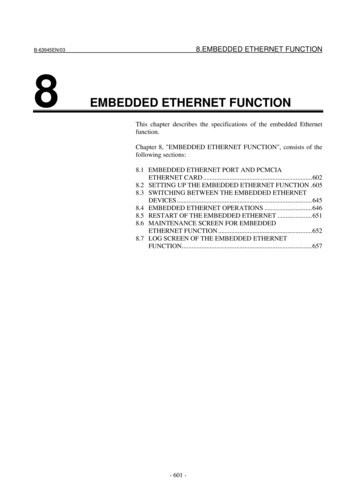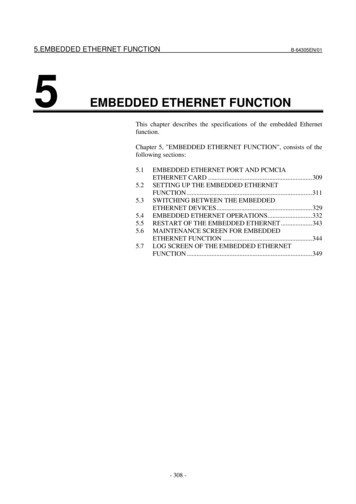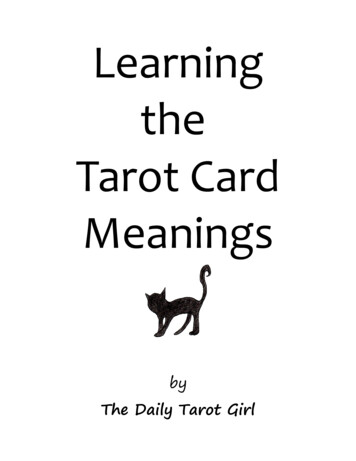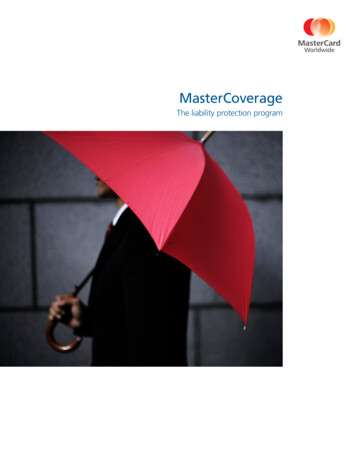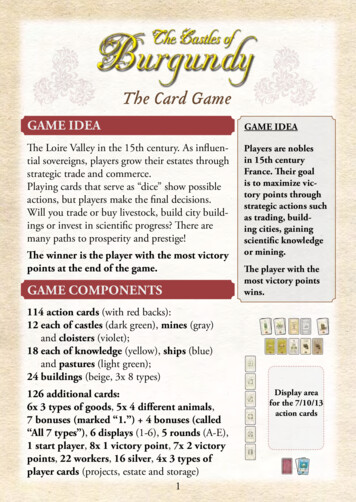
Transcription
The Card GameGame IdeaGame IdeaThe Loire Valley in the 15th century. As influential sovereigns, players grow their estates throughstrategic trade and commerce.Playing cards that serve as “dice” show possibleactions, but players make the final decisions.Will you trade or buy livestock, build city buildings or invest in scientific progress? There aremany paths to prosperity and prestige!Players are noblesin 15th centuryFrance. Their goalis to maximize victory points throughstrategic actions suchas trading, building cities, gainingscientific knowledgeor mining.The winner is the player with the most victorypoints at the end of the game.Game ComponentsThe player with themost victory pointswins.114 action cards (with red backs):12 each of castles (dark green), mines (gray)and cloisters (violet);18 each of knowledge (yellow), ships (blue)and pastures (light green);24 buildings (beige, 3x 8 types)126 additional cards:6x 3 types of goods, 5x 4 different animals,7 bonuses (marked “1.”) 4 bonuses (called“All 7 types”), 6 displays (1-6), 5 rounds (A-E),1 start player, 8x 1 victory point, 7x 2 victorypoints, 22 workers, 16 silver, 4x 3 types ofplayer cards (projects, estate and storage)1Display areafor the 7/10/13action cards
Game SetupGame SetupEach player receives the following cards:- one project, one estate, and one storage.Players place the cards on the table in front ofthem, as shown in the side bar.- one good one animal (randomly picked), one silver. Each player places these threecards in their storage (i.e. face up below theirstorage card).Each player gets:- 1 storage, 1 estateand 1 project card- 1 good 1 animal- 1 silverThe remaining good cards are shuffledand placed face up in two equal pilesat the edge of the table. Do the samewith the remaining animal cards.Place remaining goodand animal cards in2 open piles eachThe silver and the worker cards are also placedin two piles at the edge of the table.Distribute workers(0-2, depending onturn order)The youngest player is the starting playerand places the start player card face up(i.e. without question marks) besides theirestate card. The next two players to theleft each receive 1 worker card from thesupply pile, and the last player receives 2worker cards. Players place these cards intheir storage.max. 3“Estate”Starting player displayat the start of the gameThe display cards are placed from 1 to 6in rows in the middle of the table. Eachround, players will place cards beside thedisplay cards (see page 1 and below).Place display cards inrows from 1-6The 7 bonus cards (marked “1.”) areplaced above the display cards, slightlyfanned.Place bonus cards(marked “1.”) abovedisplay2
The 4 bonus cards (“All 7 types”) areplaced above the display cards, in onepile (with the 4 on top, then 3, 2, 1).Note: If there are fewer than 4 players, useonly these bonus cards: 3 players: 4 2 1; 2 players:3 1.Place the “All 7types” bonus cards ina pile, in decreasingorderThe 15 victory point cards are placedin one pile at the edge of the table.Place victory pointcardsThe 5 round cards (A-E) are placedalso in one pile (above A, then B, C,D, E).Place round cards inin increasing orderThe 114 action cards (with red backs) areshuffled and placed in one pile below the display.Each player receives 6 cards and puts them onthe table without looking at them. This is thesupply of “dice” for the first round (see below).Shuffle the actioncards and deal 6 toeach player (leavecards face down)Depending on the number of players, placethe following number of action cards face upbeside the display cards:2 pl. 7 3 pl. 10 4 pl. 13 cardsWith 2/3/4 players,place 7/10/13 actioncards face up in thedisplayPlacing the 7, 10 or 13 action cards: The first 6cards are placed one at a time from the top rowto the bottom row. With 4 players do the samewith the next 6 cards (i.e. 12 cards total). Thelast card is placed according to its die number.For example: If the last card is a 6, place it beside thedisplay-6.With 3 players the last 4 cards are placed in this way.3Possible starting displaywith 3 players:
Game PlayGame PlayThe game is played over five rounds (A to E).Each round consists of six turns.5 rounds, with6 turns in eachIn clockwise order, beginning with the startingplayer, each player picks the top two action cardsfrom their card pile and looks at the die only onthe two cards (all other information on these twoaction cards is ignored!).In turn order eachplayer discards oneof two action cardsand performs – usingthe number of thedie on it – one of sixpossible actionsThe starting player places one of the two cardsface up on a common discard pile and using thenumber indicated on the card performs one of sixpossible actions (see below).Then it is the next player’s turn. This player alsoplaces one of the two cards face up on the discardpile and performs an action, etc. When eachplayer has taken a turn, a new turn begins. Eachplayer draws the next action card, so they againhave two cards in their hand. Play continues inthis way until the last, sixth turn of each round,when all players have played their last actioncard.It is necessary to play a die, i.e. an action card,for each action. The six different possible actionsare explained on the next three pages.4Look onlyat the die!
E Action 1: “Take a card from the display”The die number on the discarded action cardindicates from which display row(1 through 6) you may take a card.Cards taken from the displayare always placed below yourproject card. No more thanthree cards can be placed undera player’s project card.Note: If there are already 3 cards underyour project card, you must discard one of the threebefore placing a new card there.E Action 2: “Place a project in your estate”The die number on the discarded action cardmust match the die numberon one of the cards from yourprojects. Take one project cardwith the matching numberfrom your projects and move itinto your estate (i.e. below yourestate card).Identical types of cards in your estate are piledone on top of the other; different types of cardsare placed next to each other.The goal is to have 3 of the same type of card inyour estate at the end of the game, entitling youto the corresponding number of victory points(shown at the bottom of the cards).When placing a project in your estate, youimmediately gain one bonus, as explained frompage 9 on.5E Take 1 cardDie number matchesa row numberPlace card underyour project cardNote: No more than3 projects are allowedat one time!E Place 1 projectDie number matchesa project numberPlace card underyour estate cardAt game end the threebuildings on the left willearn 3 victory points, thethree pastures in the middleearn 4 and the three cloisters on the right earn6 victory points.
E Action 3: “Sell goods”The die number on the discarded action carddetermines which type of good (light, mediumor dark brown) you may sell. Move all the goodcards with the matching number from your storage to the right side of your estate card, so thatthe victory points can still be seen.E Sell goodsIn addition, take one silver card from your supply for each good card sold.Take 1 silver for eachgood soldFinally, the player who sells goodsreceives the starting player card,keeping it face down (i.e. with thequestion marks showing).Note: When selling goods, a playeralways receives the start player card(face down). This also applies ifsomeone uses a ‘warehouse’ (seebelow).Seller also receivesthe (face down) startplayer cardThe die number indicates the type of goodthat may be soldImportant! Turn order of the current round doesnot change by this.E Action 4: “Restock workers to 2 cards”Regardless of which die number is onthe action card, restock your workercards to 2 only. Thus, if you have oneworker card, take one from the supply, if you have zero, take two.6E Restockworkers to 2 1 or 2 worker cards(die number doesnot matter!)
E Action 5: “Take 1 silver”Regardless of which die number is onthe action card, take one silver fromthe supply.E Take 1 silverE Action 6: “Convert workers and/or silverinto victory points”Regardless of which die number is on the actioncard, convert worker and/or silver cards intovictory points.E Convert workers/silver into victorypointsPut any number of worker and/or silver cardsback into the supply, divide the total number ofcards returned by 3, and take the resulting number of victory point cards. Place these to the leftof your estate card, so that the victory points canstill be seen.Discard any numberof workers/silver andgain 1 victory pointper 3 cards (die number does not matter!) 1 silver(die number doesnot matter!)Example: Tom returns 5 workers and 1 silver to thesupply and takes a 2-victory point card from the supply.The workersAfter discarding an action card, the player canplace a worker card back to the supply to changethe number of the discarded dieup or down by 1. Changing from1 to 6 or from 6 to 1 is possible and costs one worker card.Several worker cards may be usedto change a die number by morethan 1.Example: Megan can change a 2 to a 6 using twoworker cards.7With each workercard the die numbercan be changed 1(and from 6 to 1, orvice versa)
The silverIn addition to your normal action,once during your turn you can “buy”3 new action cards from the deck by“paying” 3 silver cards to the supply.This can happen before, during or afterperforming your normal action.Once per turn a player may buy 3 actioncards for 3 silverChoose only one of the newly purchased cardsto:Use one of the cards:- Either place it as a new project under yourproject card (remember the 3 card limit!).Either as a newproject- Or use it as action, by discarding it and usingthe die on it to take one additional action.or as another actioncard (using the die)In either case, put the remaining two newlypurchased cards on the discard pile, never to beused!!Example: Ivy discards one of the two cards in herhand and places a castle in her estate. Then she pays3 silver cards to buy the top three cards from the deck(during the middle of her castle function). She selectsanother castle and places it as a new project. She thenperforms the function of the previously placed castleand places the just bought castle into her estate. Finally,she uses the function of this newly placed castle to takeanother castle from the display and place it under herproject card.8Attention! Don tforget your regular action!
When you place a project in your estate, takethe following bonus function immediately: Mines: When you place a mine inyour estate, take two silver cards fromthe supply and place them in your storage. Mines: 2 silver Knowledges: When you place aknowledge card in your estate, take twoworker cards from the supply and placethem in your storage. It does not matterhow many workers you already own. Knowledges: 2 workersNote: The silver and the workers are not limited.Should their supplies run out, replace with analternative. Ships: When you place a ship in yourestate, take one good card from oneof the two decks and place it in yourstorage. Ships: 1 goodNote: If one deck runs out, halve the other sothere are again 2 decks. If all the good cards runout, bad luck! You don t get anything! Pastures: When you place a pasture inyour estate, take one animal card fromone of the two decks and place it in yourstorage.(Only one deck? See note for “Ships”.)9 Pastures: 1 animal
Buildings: When you place a building in yourestate, use its bonus function immediately.Important! Any three buildings can belong to a triple(different types of buildings or those of the same type).Carpenter s workshop: Take anybuilding or knowledge card from thedisplay and place it as a project. Carp. workshop: 1 building or 1 knowledgeChurch: Take any castle or mine orcloister from the display and place it asa project. Church: 1 cloister or 1 castle or 1 mineMarket: Take any ship or pasture fromthe display and place it as a project. Market: 1 pasture or 1 shipNote: When placing a carpenter s workshop,church, or market in your estate, if there is nocorresponding card in the display, bad luck!You get nothing.Watchtower: Take 1 victory point cardfrom the supply and place it beside theleft side of your estate card. Victorypoints should be visible. Watchtower: 1 victory pointBank: Take 3 silver from the supply andplace in your storage. Bank: 3 silver(Not enough silver in the supply? See note for“Knowledges”.)10
Boarding House: Take one good or oneanimal from one of the 4 open decks andplace it in your storage. Boarding House: 1 good or 1 animal(See note for “Ships”.)Warehouse: Sell one type of good fromyour storage. Warehouse:sell 1 type of good(See Action 3: “Sell Goods”.)City Hall: Immediately place anotherproject in your estate (with the resultingbonus). City Hall:place 1 additionalproject(Note: If you don t have another project, badluck! No bonus function for the City Hall.) Castles: After placing a castle in yourestate, immediately take a free action, asif you had discarded an action card withany die number. Castles: 1 free actionFor instance you could place another project(with the resulting bonus) or take a card fromthe display or or or . Cloisters: Cloisters have no immediate bonus function when placed in theestate, but they do have two advantages:- Wild: A cloister may be placed togetherwith any other type of card (this is nototherwise allowed!), and becomes a cardof that type for the rest of the game.Note: The cloister still does not grant a bonusfunction.11 Cloisters:no immediatefunction, but:- Wild (cloistersmay be added toany other type ofcards)
Always place cloisters behind the othercards, hiding the 6 victory points.This also works vice versa: When youplace a different type of card on oneor two cloisters, the cloisters change tothat type for the rest of the game.- 6 victory points: At the end of thegame a triple with only cloisters isworth 6 victory points.This cloister isnow a mine forthe rest of thegame- 6 victory points(for a triple of onlycloisters)Additional important rulesfor placing projects:- Once you have placed cards in your estate youmay not move them again.Estate cards cannotbe moved again- The first player to complete a triple receives thematching bonus card from the supply (worth 1victory point at game end). The player places itto the left side of the estate card, so the victorypoint remains visible.The first triple of atype generates thematching bonus card( 1 victory point)- Each player receives one of the current roundbonuses when completing a triple. Each playermay choose which bonus to take.For instance in round A you can choose to take either3 victory points, 2 goods, 2 animals, 3 silver, or 3workers. In round D you can either choose 2 silver, 2workers, or 1 worker 1 silver.12Each triple generatesone of the currentround bonuses3 victorypoints2 goods2 animals3 workers3 silver
- The first player who has cards of all sevencolors in their estate immediately receives thetop most card from the “All 7 types” bonuscard deck (i.e. 4, 3, 2, or 1 victory point(s) atgame end). The player places it on the left sideof the estate card so the victory points remainvisible.All 7 types of cardsin the estate generates an “All 7 types”bonus card (4/3/2/1victory points)For instance, the first player in a 3-player game receivesthe card with the 4, the second receives the 2 and thethird receives the 1.- When placing the fourth card of a type in yourestate, start a new triple with it. (It could alsoscore at game end, if completed.)Fourth card of a typestarts a new tripleEnd of a roundAt the end of six turns, after all players haveplayed their cards, the round ends. Prepare forthe next round:End of round after6 turns:- All cards remaining in the display are discarded.- discard remainingcards from thedisplay- 7, 10 or 13 new cards are placed in the display,as explained under “Game Setup”.(If necessary, reshuffle the discarded cards to create anew draw pile.)- place 7, 10 or 13new cards in thedisplay- The current round card is placed underneaththe pile, displaying a new round card.- change the roundcard- All players take another 6 cards from the drawpile and place them in a pile in front of them,drawing the top two cards for their hand.- draw 6 new actioncards to make yourdraw pile(If necessary reshuffle the discard pile and create a newdraw pile.)13
- The player with the start player card flips it faceup. This is the start player of the entire round.Play continues in clockwise order.- new start playerIf the start player card is still face up, the card is passedto the next player in clockwise order, who becomes thestart player for the entire round.Game EndGAME ENDThe game ends after the 5th round (E). In addition to regular victory points (for triples, bonuses, victory point cards, and sold goods) eachplayer also receives victory points for animals:After 5 rounds thegame ends- 4 different animals4 victory points- 3 different animals2 victory points- 2 different animals1 victory point 4/2/1 victorypoints for 4/3/2different animalsExample: Megan owns 3 sheep, 2 cattle and 1 chicken.She gets 3 victory points for this (2 for sheep cattle chicken, 1 for sheep cattle; nothing for the singlesheep).The player who has the start player card (front orback side) gets 1 victory point.Start player card: 1 victory pointThe player with the most victory points is thewinner. In case of a tie, the tied player with moreremaining cards in their storage (i.e. workers silver unsold goods unused animals) is thewinner. In case of another tie, there is more thanone winner.The player with themost victory pointswins14
Solitaire VariationSolitaireOne player fights against “Aaron” (i.e. “An AlmostReal OppoNent”, i.e. a virtual opponent).All basic rules remain the same, with the following exceptions:Setup as in a 2-playergameUse only two “All 7 types” bonus cards (as in the2 player game, i.e. the 3 and 1). Place 7 cards inthe display each round (as in the 2 player game).Place one silver, one worker, one good and oneanimal in your storage.Take 1 worker,1 silver, 1 goodand 1 animalMake 5 piles of cards for Aaron, the first pilewith 3 cards, then next with 4 cards, then 5, 6,and 7 cards (i.e. one pile per round, each roundwith one additional card). The 3 cards of thefirst pile are flipped and sorted by type. This isthe start of Aaron s estate. Cloisters are alwaysplaced as their own type, they are never addedto other types of cards. For every cloister Aarongets, you receive 1 victory point card from thesupply.Note: If Aaron gets a fourth card of the sametype, he also starts a new triple with it.Prepare 5 decksfor Aaron, with3/4/5/6/7 cardsIf Aaron completes a triple before you do, Aaronreceives the corresponding bonus card. This isalso true for the “All 7 types” bonus cards.Aaron wins bonuscards for completingtriples or “All 7types”There are no additional functions after placingAaron s cards. He does not receive any workers,silver, goods or animals. He does not get additionalactions or advantages by placing buildings orcastles. He does not get any round bonuses.15Place and sort onedeck per round forAaronDon t forget: Take 1victory point for eachof Aaron s cloisters
At the beginning of each round, Aaron s deckis sorted into his estate (possibly earning himbonuses). Afterwards, play your 6 action cardsas usual, with all the advantages from the basicgame.Play your 6 cardsas usualImportant! At the end of each round, compareyour victory points to Aaron’s: If Aaron has morevictory points than you, Aaron wins and thegame ends immediately.Important!Compare victorypoints after eachround: If Aaron hasmore, he immediatelywins!If you have the same or more victory points thanAaron, the game continues to the next round. Ifyou have the same or more victory points at theend of the game, you are the winner!Note: When you compare victory points at the end of around, be sure to add all the victory points generatedby the animals. The start player card is not used in thesolitaire game.Author and publisher thank the many play testers for theirhelp and suggestions, in particular the groups from:Bacharach, Bad Aibling, Bödefeld, Grassau, Gengenbach,Oberhof, Offenburg, Reutte, Siegsdorf and Stephanskirchen.Should you have any questions or suggestions about this game,please contact: 2015 Stefan Feld 2016 Ravensburger Spieleverlag16233451Ravensburger USA, Inc. 1 Puzzle Lane Newton, NH 03858E-Mail: info@aleaspiele.de www.aleaspiele.de
The 4 bonus cards ("All 7 types") are placed above the display cards, in one pile (with the 4 on top, then 3, 2, 1). Note: If there are fewer than 4 players, use only these bonus cards: 3 players: 4 2 1; 2 players:



